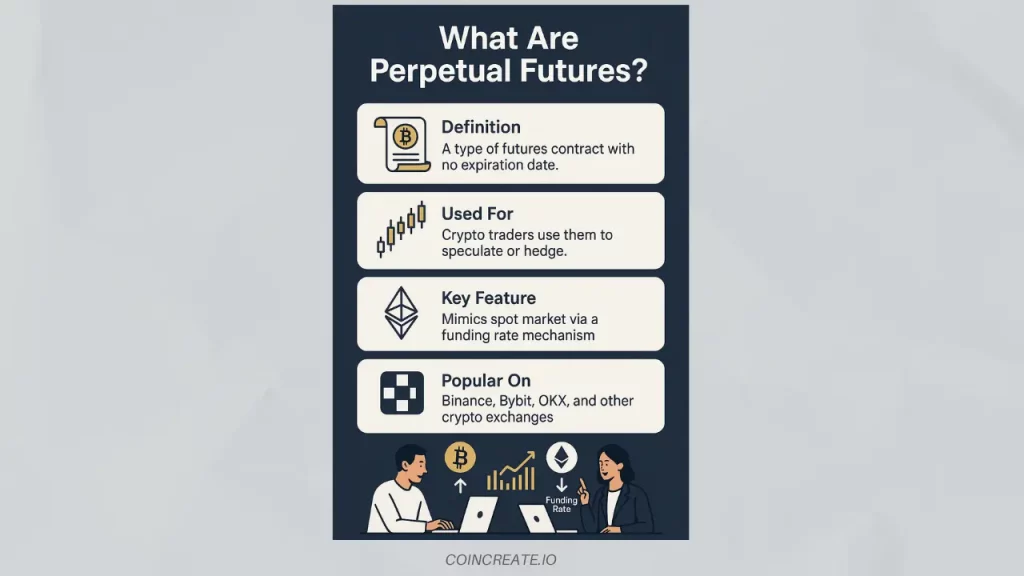What Are Perpetual Futures? How They Work & Why Trade
You’re ready to explore the crypto market, but buying and holding coins feels limiting. Perpetual futures, or perpetual contracts, offer a way to trade on price movements without owning the underlying asset. These derivative contracts let you speculate on assets like Bitcoin or Ethereum, and unlike traditional futures, they have no expiration date. This means you can hold your position as long as your strategy demands, without the need to renew or close contracts.
The idea of perpetual futures was first proposed by Nobel Prize-winning economist Robert Shiller in 1992 to create markets for illiquid assets. It wasn’t until 2016, when BitMEX introduced them to the crypto world, that they exploded in popularity. Today, platforms like Binance and Bybit make perpetual futures a go-to for traders seeking flexibility and leverage. As a trader, you’ll find perps appealing for their ability to amplify returns and adapt to fast-moving crypto markets, but they require careful navigation due to their complexity.

Why They Matter
As a trader, perpetual futures give you the power to speculate on price movements, hedge your portfolio, or amplify returns with leverage. Their no-expiry feature means you don’t need to roll over contracts, saving time and costs. However, their complexity and risks, like liquidation, mean you need a solid understanding to trade effectively.
Key Features
Perpetual futures stand out because of their unique features, which give you powerful tools to trade strategically. Here’s what makes them tick
No Expiration Date: Unlike traditional futures, perps don’t expire, so you can hold positions indefinitely without rolling over contracts. This saves you time and fees, letting you focus on market trends.
Leverage: You can trade with leverage, controlling large positions with minimal capital. For example, with 20x leverage on Binance Futures, a $1,000 margin controls a $20,000 position, amplifying both profits and losses.
Margin Trading: You post a margin—say, 5% of the position value—to open a trade. Platforms like Bybit offer flexible margin options, but you must maintain enough to avoid liquidation.
Funding Rates: To keep perp prices aligned with the spot market, funding rates are exchanged every 8 hours. If the perp price is above the spot price, longs pay shorts; if below, shorts pay longs. This ensures price parity.
Open Interest: This measures the total outstanding contracts, reflecting market liquidity. High open interest on platforms like Binance signals strong trader interest, which you can use to gauge market sentiment.
Perpetual Futures vs Traditional Futures
Wondering how perpetual futures stack up against traditional futures? Both are derivatives, letting you speculate or hedge without owning the asset, but their differences are significant
| Aspect | Perpetual Futures | Traditional Futures |
|---|---|---|
| Expiration | No expiry; hold indefinitely | Fixed expiry (e.g., monthly, quarterly) |
| Settlement | Always cash-settled | Cash or physical delivery |
| Pricing Mechanism | Funding rates align with spot price | Influenced by supply, demand, cost of carry |
| Liquidity | High in crypto markets (e.g., Bitcoin) | Varies by asset (e.g., commodities) |
| Primary Use | Crypto trading (e.g., BitMEX) | Commodities, equities (e.g., CME Futures) |
Traditional futures, like those on CME Futures, often involve physical delivery for assets like oil or grains, and they expire on set dates, requiring you to roll over contracts. Perpetual futures, pioneered by BitMEX, are cash-settled and use funding rates to stay close to the spot price, making them ideal for crypto’s fast-paced markets. As a trader, you’ll choose perps for flexibility and liquidity, but traditional futures might suit if you’re trading commodities or prefer fixed timelines.
How Do Perpetual Futures Work?
So, how do you actually trade perpetual futures? Let’s break down the mechanics to help you understand the process:
Mark Price: The mark price is a reference price, often an average of bid and ask prices, used to value your position and calculate funding payments. It ensures fairness in volatile markets, preventing manipulation.
Funding Intervals: Every 8 hours, funding payments are exchanged based on the funding rate. If the perp price exceeds the spot price, you pay as a long; if it’s lower, you pay as a short. This keeps prices aligned, as seen on platforms like dYdX.
Position Management: You open long or short positions with leverage, posting margin to cover potential losses. You must monitor your margin to avoid liquidation, where your position is closed if funds fall below the maintenance margin.
Auto-Deleveraging: If your margin drops too low, exchanges like GMX may liquidate your position automatically to protect the market. This ensures stability but can lead to losses if the market moves against you.
Risks and Rewards of Trading Perpetuals
Perpetual futures can supercharge your trading, but they’re a double-edged sword. Here’s what you stand to gain and lose
| Rewards | |
|---|---|
| High Leverage | With leverage up to 100x on some platforms, a small price move can yield massive returns. For instance, a 1% Bitcoin price increase with 50x leverage means a 50% profit on your margin. |
| Flexibility | No expiry means you can ride long-term trends without renewing contracts, perfect for capturing crypto’s volatility. |
| Market Versatility | Go long or short to profit in rising or falling markets, giving you opportunities in any condition. |
| Risks | |
| Liquidation | If the market moves against you, your position can be liquidated if your margin falls below the required level, wiping out your investment. |
| Volatility Exposure | Crypto’s wild price swings, like Bitcoin’s 20% daily moves, can trigger liquidations quickly. |
| Funding Fees | Frequent funding payments, especially in imbalanced markets, can erode profits or add to losses. |
| Overleveraging | High leverage amplifies losses as much as gains. Using 100x leverage might seem tempting, but a 1% move against you could lead to a total loss. |
Using DeFi platforms or trading bots can streamline your strategy, but they don’t eliminate risks. Always set stop-loss orders and trade within your risk tolerance to protect your capital.
Real-World Examples
To see perpetual futures in action, let’s explore practical scenarios that show how you can use them
- BTC/USDT Perpetual vs BTC Spot: Bitcoin’s spot price is $50,000, but the BTC/USDT perpetual on Binance Futures trades at $50,200 due to bullish sentiment. If you expect the premium to grow, you go long, profiting as the perp price rises. If you predict the premium will shrink, you short, betting on convergence with the spot price.
- Funding Arbitrage: Suppose the funding rate on dYdX is positive, meaning longs pay shorts 0.05% every 8 hours. You open a short position to collect these payments while holding a spot Bitcoin position to hedge. This strategy lets you earn funding fees with minimal price risk.
- Perpetual vs Quarterly Contracts: Unlike perps, quarterly futures expire every three months. If you expect a Bitcoin rally before a quarterly expiry, you might choose a quarterly contract on CME Futures. But if you want to hold longer without expiry concerns, perps on GMX are ideal.

